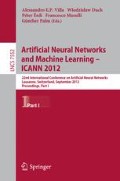Abstract
The detection and categorization of animate motions is a crucial task underlying social interaction and decision-making. Neural representations of perceived animate objects are built into cortical area STS which is a region of convergent input from intermediate level form and motion representations. Populations of STS cells exist which are selectively responsive to specific action sequences, such as walkers. It is still unclear how and to which extent form and motion information contribute to the generation of such representations and what kind of mechanisms are utilized for the learning processes. The paper develops a cortical model architecture for the unsupervised learning of animated motion sequence representations. We demonstrate how the model automatically selects significant motion patterns as well as meaningful static snapshot categories from continuous video input. Such keyposes correspond to articulated postures which are utilized in probing the trained network to impose implied motion perception from static views. We also show how sequence selective representations are learned in STS by fusing snapshot and motion input and how learned feedback connections enable making predictions about future input. Network simulations demonstrate the computational capacity of the proposed model.
Access this chapter
Tax calculation will be finalised at checkout
Purchases are for personal use only
Preview
Unable to display preview. Download preview PDF.
References
Baker, C.I., Keysers, C., Jellema, T., Wicker, B., Perrett, D.I.: Neuronal representation of disappearing and hidden objects in temporal cortex of the macaque. Exp. Brain Res. 140, 375–381 (2001)
Barraclough, N.E., Xiao, D., Oram, M.W., Perrett, D.I.: The sensitivity of primate STS neurons to walking sequences and to the degree of articulation in static images. Progress in Brain Res. 154, 135–148 (2006)
Bayerl, P., Neumann, H.: Disambiguating visual motion through contextual feedback modulation. Neural Computation 16, 2041–2066 (2004)
Carpenter, G.A., Grossberg, S. (eds.): Pattern recognition by self-organizing neural networks. MIT Press, Cambridge (1991)
Casile, A., Giese, M.A.: Roles of Motion and Form in Biological Motion Recognition. In: Kaynak, O., Alpaydın, E., Oja, E., Xu, L. (eds.) ICANN 2003 and ICONIP 2003. LNCS, vol. 2714, pp. 854–862. Springer, Heidelberg (2003)
Escobar, M.-J., Masson, G.S., Vieville, T., Kornprobst, P.: Action recognition using a bio-inspired feedforward spiking network. Intl. J. of Computer Vision 83, 284–301 (2009)
Földiak, P.: Learning invariances from transformation sequences. Neural Computation 3, 194–200 (1991)
Giese, M.A., Poggio, T.: Neural mechanisms for the recognition of biological movements. Nat. Rev. Neurosci. 4, 179–192 (2003)
Hansen, T., Neumann, H.: A recurrent model of contour integration in primary visual cortex. J. of Vision 8(8), 1–25 (2008)
Jellema, T., Perrett, D.I.: Cells in monkey STS responsive to articulated body motions and consequent static posture: a case of implied motion? Neuropsychologia 41, 1728–1737 (2003)
Jhuang, H., Serre, T., Wolf, L., Poggio, T.: A biologically inspired system for action recognition. In: Proc. IEEE 11th Intl. Conf. on Computer Vision, ICCV 2007, Rio de Janeiro, Brasil, October 14-20 (2007)
Kourtzi, Z., Kanwisher, N.: Activation of human MT/MST by static images with implied motion. J. of Cognitive Neuroscience 12, 48–55 (2000)
Oja, E.: A simplified neuron model as a principal component analyzer. J. of Math. Biology 15, 267–273 (1982)
Oram, M.W., Perrett, D.I.: Integration of form and motion in the anterior superior temporal polysensory area (STPa) of the macaque monkey. J. of Neurophysiology 76(1), 109–129 (1996)
Schindler, K., Van Gool, L.: Action snippets: How many frames does human action recognition require? In: Proc. IEEE Conf. on Computer Vision and Pattern Recognition, CVPR 2008, Anchorage, Alaska, USA, June 22-24 (2008)
Singer, J.M., Sheinberg, D.L.: Temporal cortex neurons encode articulated actions as slow sequences of integrated poses. J. of Neuroscience 30(8), 3133–3145 (2010)
Author information
Authors and Affiliations
Editor information
Editors and Affiliations
Rights and permissions
Copyright information
© 2012 Springer-Verlag Berlin Heidelberg
About this paper
Cite this paper
Layher, G., Giese, M.A., Neumann, H. (2012). Learning Representations for Animated Motion Sequence and Implied Motion Recognition. In: Villa, A.E.P., Duch, W., Érdi, P., Masulli, F., Palm, G. (eds) Artificial Neural Networks and Machine Learning – ICANN 2012. ICANN 2012. Lecture Notes in Computer Science, vol 7552. Springer, Berlin, Heidelberg. https://doi.org/10.1007/978-3-642-33269-2_37
Download citation
DOI: https://doi.org/10.1007/978-3-642-33269-2_37
Publisher Name: Springer, Berlin, Heidelberg
Print ISBN: 978-3-642-33268-5
Online ISBN: 978-3-642-33269-2
eBook Packages: Computer ScienceComputer Science (R0)

